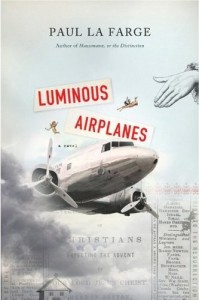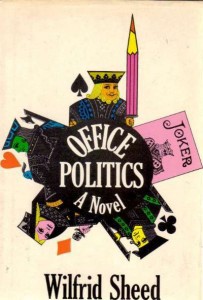Books & Culture
REVIEW: Luminous Airplanes by Paul La Farge

Luminous Airplanes
Paul La Farge
Farrar, Straus and Giroux
242 pp / $25
Located at the intersection of memory and imagination, nostalgia is something that defines linear narrative, the same way a datebook, no matter how accurate, never really recreates the sensory memory of how it felt to live one particular day. In Luminous Airplanes, Paul LaFarge’s inventive new book, nostalgia is a device that allows for both an accurate rendering of the dot-com boom years as well as a compelling narrative drive. LaFarge knows that nostalgia crosses boundaries of time and place and that this, in some sense, is the strength of combining the written text with an “immersive text” online, which allows the reader to experience non-linear time and reinterprets nostalgia for the modern age.
Luminous Airplanes is essentially a coming-of-age tale that moves fluidly from past to present, from San Francisco to New York City to Thebes (a sleepy town in upstate New York). The narrator himself is a failed historian-slash-computer programmer — both professions concerned with reconstructions of a sort — during the halcyon years before 9/11, a time when nostalgia feels particularly piercing. He returns to Thebes to clean out his grandparents’ house, which leads him to seek out testimonial and documentary evidence about his father, whom he never knew, and rekindle a flame with his childhood crush, Yesim. The book itself is presented as a written document produced by the narrator in an attempt to reclaim and rewrite part of his personal history.
The book contains a myriad of fantastical digressions: Progress in Flying Machines, a book-within-the-book that describes the “hopeless invention” of flight; ruminations on the narrator’s unfinished dissertation on the Millerites, an apocalyptic Christian sect who await the end of the world in “white gowns;” reconstructions of the narrator’s father’s past; and episodes in technology-crazed San Francisco, where abandoning your graduate studies to create unimagined technology seemed like a wise idea. Yet despite the dream-like tapestry the narrative weaves, Luminous Airplanes operates in a uniquely classical mode for the novel, achieving rather effortlessly a clear narrative structure. The narrator himself worries over the melding of present and past, asking himself, “Was I accomplishing anything by revisiting the past? Wasn’t my problem that I lived too much in the past already?” He frets over the purpose of all of his efforts, acknowledging that the novel never really tells the whole story even as it poses as something real: “Even if I had somehow managed to tell the story of every person I’d ever known, what I would have written would be, like Thebes, only a little world, which seemed complete while you were in it, but in fact was not complete.”
The narrator’s worries seem to speak to the current fears about the novel’s traditional form even as he acknowledges the limits of written history. In other works, LaFarge has played around with the forms of the novel, posing once as the putative translator of others’ dreams, adding woodcut illustrations to another. As a seemingly playful response to the narrator’s worries, Luminous Airplanes, the existent text, moves beyond the three-dimensional form; LaFarge has created an “immersive text” that lives on the internet and includes the entire text of the print novel on top of an ever-growing list of additional segments. The sections are hyperlinked, so I found myself digressing from the main narrative to detailed sections on a Nevada festival resembling Burning Man (theme: Contact With Other Worlds) to a short exegesis on W.G. Sebald. There is an “index,” which is incredibly long and detailed. I was so overwhelmed that I immediately defaulted to the “start at the beginning” option, only to realize it was the same text I had read in the print copy. For some time, I flipped from the print book to the immersive text to see where it matched and what, exactly, I had missed — an exercise in hyper-vigilance that seems somehow befitting for the themes of the book. I was, like the narrator, panicked at the idea of something being left undiscovered, afraid that I had missed “another world wanting to make contact.”
In this way, the book itself doesn’t stand as a mere response to publishing woes or the state of the novel or even the post-9/11 world, but, rather, it is an interesting contemplation of these things stacked up against the innate desire for a life narrative, for things to finally make sense. LaFarge jokes on the website that the immersive text requires three people, “preferably friends,” to traverse the entire expanse: one should be the “lead” reader, one is “the kind of reader who purchases annotated editions of classic books,” and the last is “a very dull reader to whom the words at first are a jumble, but who, slowly, as if she had never read a book before, makes sense out of the jumble.” His explanation reminded me of Adventure, a text-only computer game the narrator creates that slowly prompts the player through “a dark and gloomy cave.” Every time the computer is turned off for the night, the game is completely lost, and the narrator must painstakingly re-type it from the beginning.
Lucky for modern computer users, the internet isn’t lost every time we log off, but, in exchange, the depth of material is so vast and ever-changing that the readers get lost in the swell. The immersive text seems to invite this total loss and complete submission — we will never know the entire story or plumb its depths. History, as the narrator writes, can never really be explained in all of its fullness, but the goal is “to know it well enough that you can move on.” Yet, his comment also resonates with the paradoxical desire for rediscovery we often feel when books end (hence, the desire for sequels) — moving on just isn’t that easy. The pleasure of reading itself is a form of spelunking without much light, a safe way of losing ourselves. It’s like the failed attempts in Progress in Flying Machines to fly without any fear of death, both preparing for the apocalypse and knowing that it will never come. This view of reading nostalgically recalls the fun that reading a novel can be, the complete absorption we all once had in alternate realities. Why else do we read novels except to make contact with some other world?
***
— Jessica Pishko is a current MFA candidate in fiction at Columbia University. She also has a J.D. from Harvard Law School. You can follow her on Twitter @jesspish.









